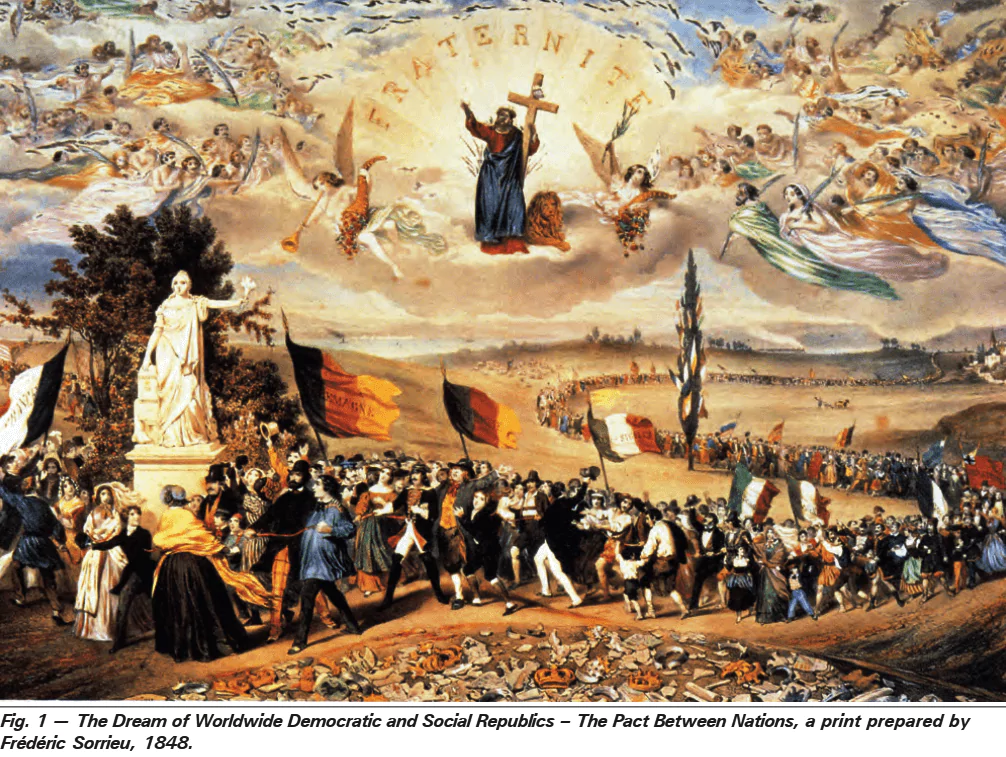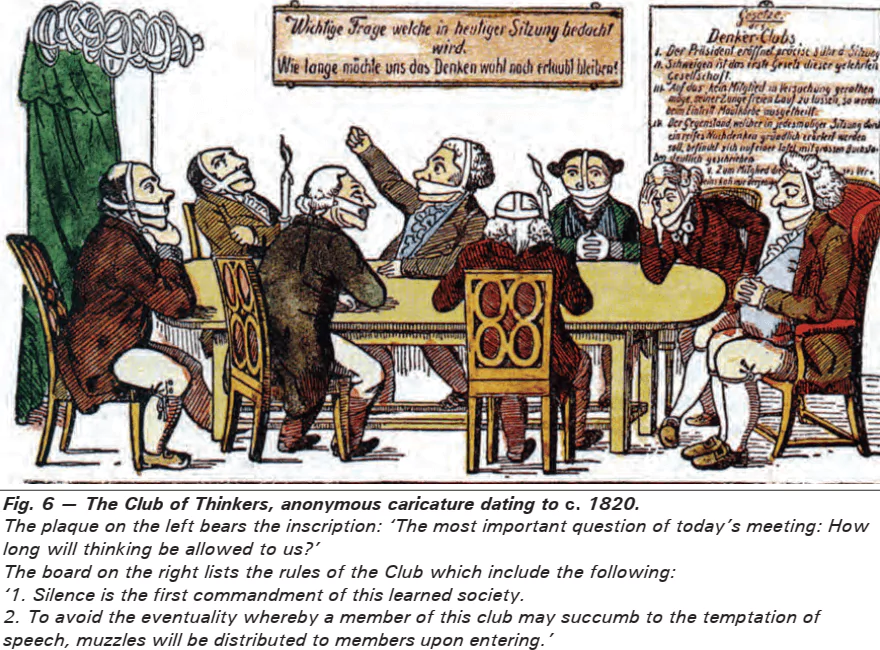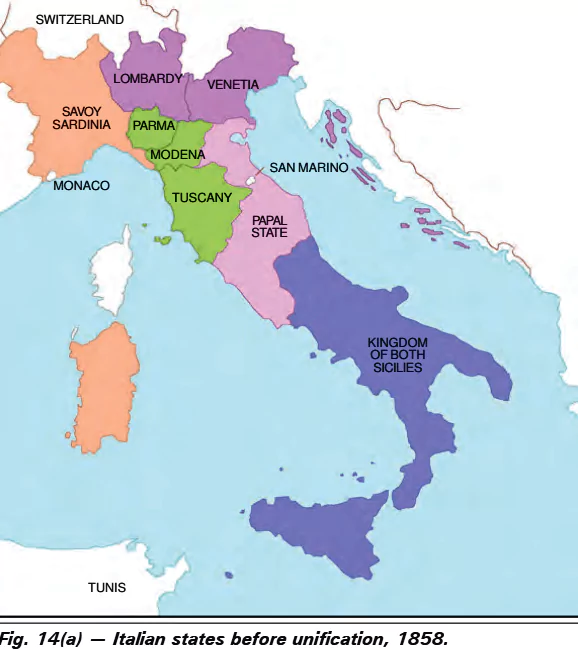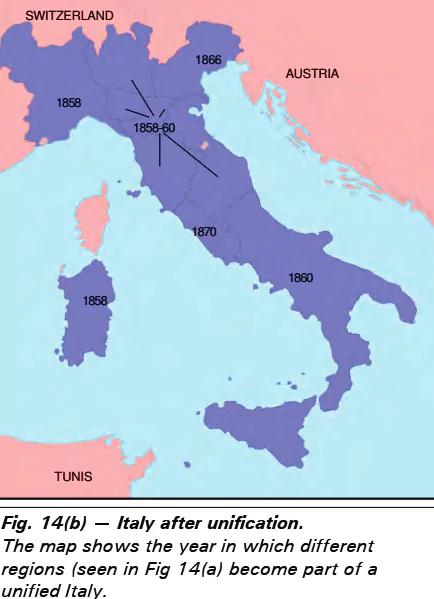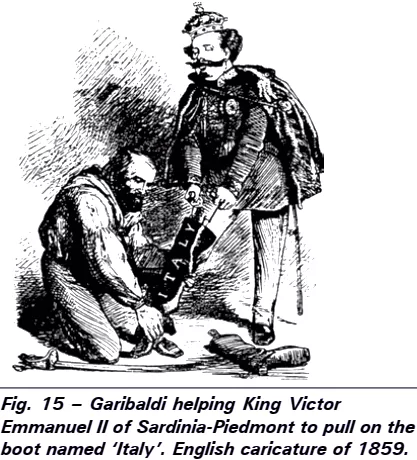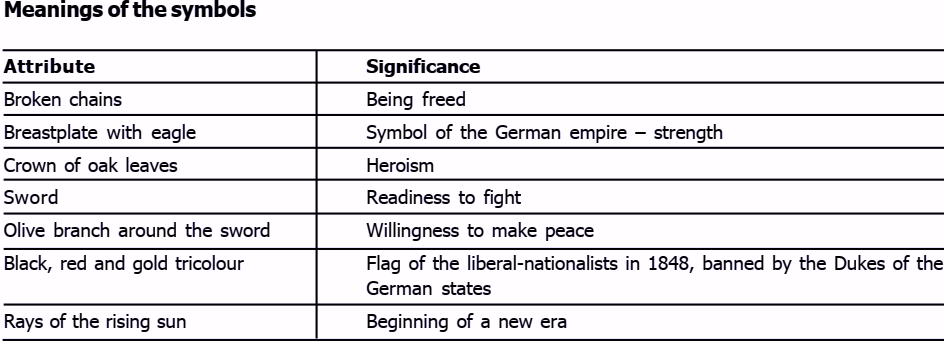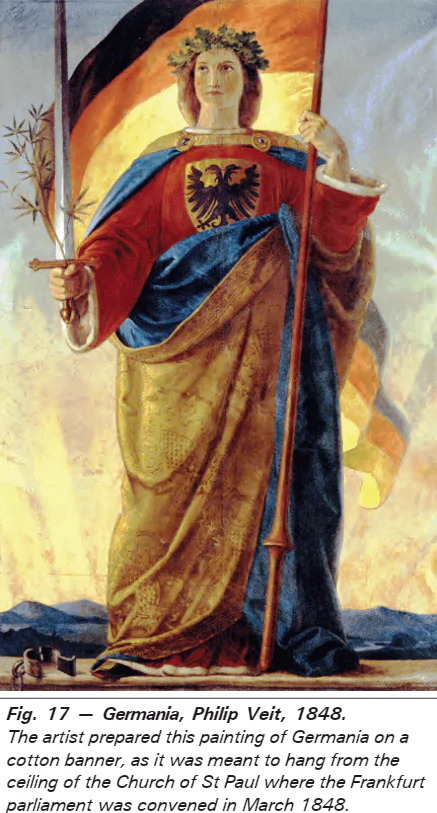NCERT Solution for Class 10 History – Chapter 1 The Rise of Nationalism in Europe
In-Text Questions
Activity (Page 3)
Question.1. In what way do you think this print (Fig. 1 as shown below) depicts a utopian vision?
Answer. The print was a utopian vision coz:-
- All countries were together.
- The countries were supposed to be nation which didn’t existed till then.
- Men, women and children were given equal status.
Discuss (Page 4)
Question.2. Summarize the attributes of a nation, as Renan understands them. Why, in his view, are nations important?
Answer. Ernst Renan was a French philosopher who delivered a speech at the University of Sorbonne in 1882. In his speech he outlined the idea of what makes a nation. According to Renan, nations are formed by a common language, race, religion or territory. It is the culmination of a long past of endeavor, sacrifices and devotion. A nation does not take any interest in annexing or holding onto another Nation against its will.
Nations are important because their existence guarantee Liberty. The liberty of individuals would be lost if they are no nations.
Discuss (Page 10)
Question.3. Describe the political ends that List hopes to achieve through economic measures.
Answer. A customs union known as Wolverine was formed at the initiative of Prussia and joined by most of the German states. This union removed internal impediments and summed up 32 currencies into two. Besides this, it the aim of the union is to bind the Germans economically into a nation by strengthening the nation materially through its protection of interests externally and stimulating its internal production.
Activity (Page 11)
Question.4. Plot on a map of Europe the changes drawn up by the Vienna Congress.
Answer. The Vienna Congress in 1815 changed the boundaries of Europe after the Napoleonic era. The boundaries were changed to make a strong France. Many countries opposed this, but it was remapped with Russia taking most parts of the Napoleonic under its control. The new states with new border were created although Europe with Switzerland being neutral territory. Although Napoleon escaped while in exile but was defeated in Waterloo.
Discuss (Page 11)
Question.5. What is the caricaturist trying to depict?
Answer. The caricaturist is depicting the club of liberal nationalists which dates back 1820. Conservative regimes were set up in 1815. These regimes were autocratic they were not ready to tolerate criticism and dissent. They curbed all the actions which put a question mark on the legitimacy of autocratic governments. Most of the regimes had imposed censorship law to have control over freedom of the press and over songs motivating the ideas of liberty.
Discuss (Page 15)
Question.6. Discuss the importance of language and popular traditions in the creation of national identity.
Answer. A person is identified as belonging to a particular nation by his cultural traditions and the language that he speaks. The language as well as the traditional practices usually develop and get established over a long period of many hundreds of years.
They give an identity to an individual wherever he is. For instance, a Frenchman will normally speak the French language fluently. He will also follow French traditions and customs wherever he is in the world, as he would have imbibed them in his family from his childhood days. Thus, he will be identified as a French national.
Discuss (Page 16)
Question.7. Describe the cause of the Silesian weavers’ uprising. Comment on the viewpoint of the journalist.
Answer. The cause of the Silesian weaver’s uprising was the cheating of the weavers by the contractors. In 1845, the weavers raised a revolt against the contractors who used to supply them raw material to weave textiles in finished form. The contractors drastically reduced their payments. The viewpoint of the journalist Wilhelm Wolft for this uprising was as fellows- Weaver’s crowd reached the house of the contractor and demanded higher wages.
They were not treated well, so a group of the crowd entered the contractors house forcibly and destroyed the furniture, window panes, plundered it. This shows that the viewpoint of the journalist was biased against the weavers and in favour of the contractor. On the other hand, the journalist did not understand the root cause of the uprising. He did not understand the poverty of weavers.
Activity (Page 16)
Question.8. Imagine you are a weaver who saw the events as they unfolded. Write a report on what you saw.
Answer. I have worked very hard to supply the woven cloth in time, but received very little payment than what was agreed to by the contractor. Since, other weavers had also got less payment, on the afternoon of 4th June, I went along with my partner and other weavers to the contractor’s house for asking for better wages for our weaving.
Our demands were scornfully refused and we were even threatened that no more work would be given to us if we did not work at the same rate as what was paid to us. Some of my fellow weavers got angry at this and broke the windowpanes of the contractor’s house, barged inside and damaged his furniture and crockery.
Some weavers also broke open his store of woven cloth and tore it all up. Seeing this, the contractor ran away from the house with his family to a nearby village, but there also he did not get shelter. Next day, the contractor returned with soldiers from the army, who fired at our group of weavers, killing eleven of us. I was injured in the leg by a bullet and now, I am nursing my wounds as I write this.
Discuss (Page 18)
Question.9. Compare the positions on the question of women’s rights voiced by the three writers cited above. What do they reveal about liberal ideology?
Answer. The liberal politician Carl Welcker, an elected member of the Frank furt Parliament, says that-
- Woman is weaker than man and her sphere is the home where she keeps children and does household duties such as cooking, washing and cleaning, etc.
- Equality between the sexes or woman and man would only endanger harmony and destroy the dignity of the family.
According to Louise Otto-Peters, a political activist and founder of a woman’s journal and a feminist political association, Men who try to gain freedom and liberty for all do not obey this but their untiring efforts are intended for the welfare of only men. She advocated that liberty cannot be divided among the men and women.
An Anonymous writer says that-
- It is injustice to discriminate against women on the basis of gender.
- The women should not be deprived of the right to vote while an illiterate man has given the right to vote.
The above discussion shows that Louise Otto-Peters and the Anonymous writer favor woman on the basis of rights of liberty and equality. The first writer does not favor woman’s rights of liberty and equality.
Activity (Page 20)
Question.10. Describe the caricature. How does it represent the relationship between Bismarck and the elected deputies of Parliament? What interpretation of democratic processes is the artist trying to convey?
Answer. The caricature depicts Bismarck, Chancellor of Germany as holding a whip (signifying that he is a ruthless man ruling with an iron hand) while leading the Parliament. The deputies who were elected are afraid of him and so are hiding under their tables. The caricature depicts the dominance of Bismarck over the deputies and how he despised liberalism and parliamentary assemblies. The artist is trying to convey that the democratic process in Germany was very shallow and the roots of constitutionalism were poor.
Activity (Page 21)
Question.11. Look at Fig. 14(a). Do you think that the people living in any of these regions thought of themselves as Italians?
Answer. In 1858, Italy was divided into seven states, with the North being under the Austrian Habsburgs, the centre being ruled by the Pope and the Southern regions being under Spain’s domination. Only one state, Sardinia-Piedmont was ruled by an Italian princely house. The Italian language also had not acquired a common form and had many regional and local variations. So people living in these regions, except Sardinia -Piedmont, would not have thought of themselves as Italians.
Question.12. Examine Fig. 14(b). Which was the first region to become a part of unified Italy? Which was the last region to join? In which year did the largest number of states join?
- The first regions to become a part of unified Italy in 1858 were Savoy Sardinia followed by the Northern states.
- The last region to join was the Papal State in 1870.
- The largest number of states joined in 1860.
Activity (Page 22)
Question.13. The artist has portrayed Garibaldi as holding on to the base of the boot, so that the King of Sardinia-Piedmont can enter it from the top. Look at the map of Italy once more. What statement is this caricature making?
Answer. The base of the boot symbolizes the Kingdom of the Two Sicilians, which lay in the southernmost part of the Italian peninsula. Garibaldi had won this kingdom and handed it over to King Victor Emmanuel II. This cartoon signifies the unification of Italy and Garibaldi’s role in it.
Activity (Page 24)
Question.14. With the help of the chart in Box 3, identify the attributes of Veit’s Germania and interpret the symbolic meaning of the painting. In an earlier allegorical rendering of 1836, Veit had portrayed the Kaiser’s crown at the place where he has now located the broken chain. Explain the significance of this change.
Answer. The symbolic meaning of the painting is that the German nation has emerged. The female figure of Germania is an allegory of the German nation. All the attributes of the German nation out be seen in the painting as given in the chart. The replacement of the Kaiser’s crown with the broken chain signifies that the German nation is now free from autocratic monarchical rule.
Activity (Page 24)
Question.15. Describe what you see in Fig. 17. What historical events could Hübner be referring to in this allegorical vision of the nation?
Answer. Julius Hübner painted this picture of Germania, allegory of the German -nation, in 1850, 2 years after the national assembly at Frankfurt was rejected by the monarchs. In the foreground of the picture, there are symbols of absolutism and Germania lies before it. This shows that the united hope if German becoming a nation is now shriveled. And the entire nation falls down before the monarchy.
Thus, the Frankfurt parliament being forced to disband, by the monarchs, was the event Hübner is referring to in his painting.
Activity (Page 25)
Question.16. Look once more at Fig. 10.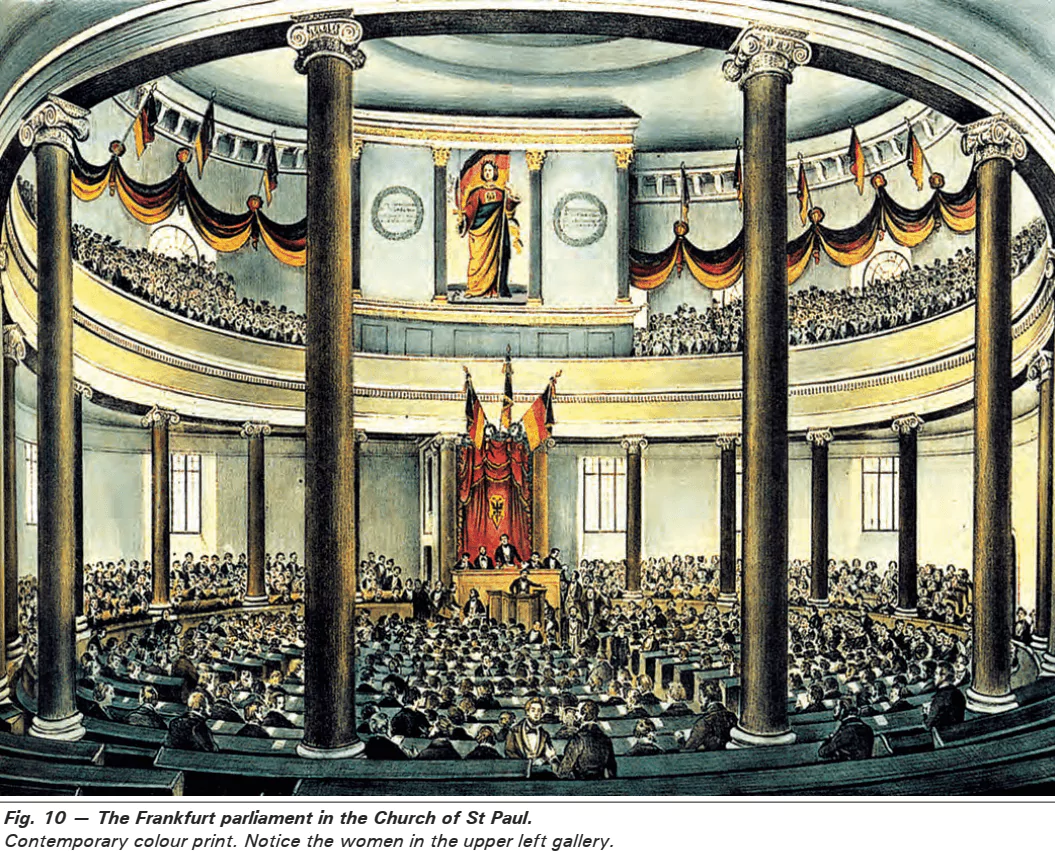
(a) As a man seated in the hall of deputies, and
(b) As a woman observing from the galleries, relate to the banner of Germania hanging from the ceiling?
Answer. (a) As a man seated in the hall of deputies, I would relate positively to the banner of Germania, as I would feel all that it symbolized was coming true.
(b) As a woman observing from the galleries, I would consider the banner to depict the truth only partially Women had participated with men equally in the struggle for constitutionalism with national unification, but they were denied suffrage rights during elections to the National Assembly, Women were only admitted to the assembly as passive citizens and observers.
NCERT Exercise Solution
Write in brief
Question.1. Write a note on:
(a) Giuseppe Mazzini
Answer.
- Giuseppe Mazzini was born in Genoa on June 22nd, 1807 in a middle class family.
- He was a patriot, Italian revolutionary, founder of Young Italy and an important figure in liberal nationalism.
- He was one of the three revolutionaries who made a significant contribution in Italian unification. His efforts led to the unification of Italy.
- In 1830, he joined the revolutionary Carbonari (a secret association with political purposes) for which he was arrested soon and put in jail.
- There he organised a new political society called Young Italy, whose basic principle was the union of the several states and kingdoms into one republic.
- He founded underground societies like Young Italy in Marseilles, and Young Europe in Berne.
- To evoke people’s reaction Mazzini wrote several essays that voiced the injustice to the working class such as the peasants, professionals, artists, and intellectuals.
- He was elected as a member of a constituent assembly and acquired the responsibility of framing a constitution for the Roman Republic.
(b) Count Camillo de Cavour
- Count Camillo de Cavour, a political leader and an Italian statesman, was born at Turin on the 1st of August 1810.
- At the age of ten he entered the military academy at Turin.
- He was a significant figure in the movement towards Italian unification and the founder of the original Italian Liberal Party
- He founded the Agrarian Association in 1842 and the newspaper Il Risorgimento in 1847, where he struggled to establish a constitutional monarchy.
- Cavour was a liberal and had faith in free trade, public right of opinion and secular rule. So on becoming the prime minister of Piedmont Sardinia on 4 November 1852 Cavour strengthened the kingdom, reformed taxation, stabilised the currency, and improved the railway system.
- In 1853, he supported the French and British in the Crimean War with troops, in anticipation to enhance the prestige of Piedmont Sardinia.
- On March 17, 1861 when Victor Emmanuel II became the king of Italy, Cavour was formally declared as the prime minister of Italy.
- Count Camillo de Cavour made considerable efforts for the creation of a modern Italian state. But unfortunately he died only three months after the declaration of a United Italy on 6 June 1861.
(c) The Greek war of Independence
Answer.
- Greece had been a part of the Ottoman Empire since the fifteenth century.
- The growth of revolutionary nationalism in Europe sparked off a struggle for independence among the people of Greece. It began in 1821.
- Nationalists in Greece got support from other Greeks living in exile and also from several West Europeans who had soft corners for the ancient Greek culture.
- Poets and artists lauded Greece as the cradle of European civilization and mobilised public opinion to support its struggle against the Ottoman Empire.
- Finally, with the Treaty of Constantinople of 1832 Greece became an independent nation.
(d) Frankfurt Parliament
Answer. In 1848, Germany was a divided country with different provinces like Austria and Prussia. In February 1848, when a rebellion took place in Paris King Louis Philippe was forced to run away. This ultimately boosted the confidence of other countries also and revolts started throughout Europe. Many German cities were shaken by revolts of crowds. This led to the fall of the conservative governments and liberals called for the National Assembly. It was attended by 831 delegates from all over Germany in a church in Frankfurt on May 18, 1848. Friedrich Wilhelm IV was elected as the president but it turned out to be futile due to lack of experience of the deputies. Instead of setting up a central power in Germany, the deputies debated about the fundamental rights of the German people. However, the Assembly continued its work and completed a Constitution. Radical political groups in Germany tried to impose the Constitution through civil war, but were suppressed.
(e) The role of women in nationalist struggles
Answer.
- A large number of women participated actively in the political matters over the years.
- They formed many political associations, founded newspapers and took part in political meetings and demonstrations.
- This grabbed the attention of delegates of the Frankfurt parliament. So, on 18 May 1848, when the Constitution was drafted in the Frankfurt parliament the controversial issue of extending political rights to women was raised.
- Still women were deprived of suffrage rights during the election of the Assembly and they were admitted in the Frankfurt parliament assembly only as spectators.
- But this did not diminish their contribution to the national struggle.
- Delphine de Girardin, an educated woman, criticised by saying that if servants doing the household work were granted the right to vote then why not women who are mothers, housewives managing everything at home.
Question.2. What steps did the French revolutionaries take to create a sense of collective identity among the French people? (OR)
When did the first clear cut expression of nationalism come in France? How did the French Revolution lead to the transfer of sovereignty from the monarchy to a body of French citizens? Explain any four measures taken by the French revolutionaries.
Answer. The first clear cut expression of nationalism came in France with the French Revolution. To make the Revolution a success it was very important to instill a sense of unity in every citizen. To achieve it, various measures and practices were followed:
- A new French flag, the tricolour, was chosen to replace the former royal standard.
- The Estates General was elected by the body of active citizens and renamed the National Assembly.
- The ideas of la patrie (the fatherland) and le citoyen (the citizen) emphasised the nation of a united community enjoying equal rights under a constitution.
- New hymns were composed, oaths taken and martyrs commemorated, all in the name of the nation.
- A centralised administrative system practising uniform laws for all citizens within its territory was set up.
- Internal custom duties and dues were abolished and a uniform system of weights and measures was adopted.
- Regional languages were discouraged and French was adopted as the common language of the nation.
Question.3. Who were Marianne and Germania? What was the importance of the way in which they were portrayed?
Answer. In olden times the best way to present an idea was through symbolic personifications. This was the most common and appealing way to invite people’s attention. From 1789 females appeared in paintings as symbol of liberty and revolution. During the French Revolution, many symbolic personifications of ‘Liberty’ and ‘Reason’ appeared. Marianne was the female figure invented by artists in the nineteenth century to represent the French nation. Her characteristics were drawn from those of Liberty and the Republic—the red cap, the tricolour, the cockade. Statues of Marianne were erected in public places to remind the public of the national symbol of unity and to persuade them to identify with it. Marianne images were marked on coins and stamps.
Similarly, Germania became the symbol of the German nation. This work was done by the artist Philip Veit. He depicted Germania as a female figure standing against a background where beams of sunlight shone through the tricolour fabric of the national flag. Germania was wearing a crown of oak leaves, as the German oak stands for heroism.
Question.4.Briefly trace the process of German unification.(OR)
Examine the main features of the process of German unification under the leadership of Otto Von Bismarck.
Answer. German unification was a long and complicated process. At the beginning of the 19th century, Germany was not a unified country. It was a collection of autocratic states (39 in all), where only the very wealthy and powerful ruled. It was a difficult affair to unite Germany. It took a long time to unite Germany into one country and the credit goes to Bismarck. He fought three wars to unify Germany.
- Danish-Prussian War in 1864: The 1864 Danish War helped Bismarck strengthen his internal position in Prussia. Danish King Friedrich VII died in 1864. Many European royals were independent having undersized territories. Often these territories were divided by different laws, customs, and even languages. Without much effort, Prussia defeated Danish. The Danish War was the first step in the unification of Germany.
- Austro-Prussian War in 1866: In 1866 relations between Austria and Prussia worsened over the control of Schleswig-Holstein. However, the real concern was to emerge as the dominant force in Germany. Bismarck provoked quarrels with the Austrians to gain supremacy in Germany. He tactfully secured Italian support and French neutrality. Prussian troops occupied Holstein and the “Seven Weeks War” broke out between Prussia and Austria. During the Seven Weeks War (1866) Austria was totally crushed by Prussian forces at the Battle of Sadowa, and was completely removed from any role in German affairs. An extraordinary lenient treaty “The Treaty of Prague” was signed to expel Austria from the German Confederation so that Austria did not remain an enemy of Prussia. Prussia was now able to dominate the other German states without fear of Austrian intervention.
- North German Confederation in 1866: After defeating Austria, Bismarck organised the North German Confederation in 1866. It was composed of Prussia and 17 small northern German states. It contained all German states. North of the Main River was successfully controlled by Prussia. The remaining German states were eventually forced to join, including Bavaria, Württemberg, Baden and Hesse-Darmstadt. Bismarck was now ready to take on France.
- Franco-Prussian War in 1870-71: To complete German unification Bismarck had to deal with France. In 1870 Bismarck purposely created war with France. Bismarck suggested a German candidate’s name for the vacant Spanish throne. The hidden aim behind this move was to make the French emperor Napoleon III angry and declare war on Prussia and the North German Confederation. Prussia was completely victorious over France at the Battle of Sedan in 1870 and gained control over Alsace-Lorraine.
For unification Bismarck followed ‘Blood and Iron’ policy. Thus, the long planned journey of German unification was completed in 1871 A.D.
Question.5. What changes did Napoleon introduce to make the administrative system more efficient in the territories ruled by him?
Answer. Though Napoleon was a dictator and was against democracy but he took certain measures to smoothly and proficiently run the administrative system.
- Napoleon reformed the French legal system because the old feudal and royal laws were very confusing and conflicting to the people.
- The Napoleonic Code of 1804 was a major step in establishing the rule of law. This Code was exported to the regions under French control.
- In countries like the Dutch Republic, Switzerland, Italy and Germany feudalism was abolished and peasants were freed from serfdom and manorial dues.
- All privileges based on birth were taken away. The equality before the law was established and the right to property was secured.
- Transport and communication systems were also paid attention and were improved.
- Low class people like peasants, artisans, workers and new businessmen were given more freedom.
- Uniform laws were adopted for all. Be it a businessman and a small-scale producer of goods—all began to realise that uniform laws, stadardised weights and measures, and a common national currency would facilitate the movement and exchange of goods and capital from one region to another.
Discuss
Question.1. Explain what is meant by the 1848 revolution of the liberals. What were the political, social and economic ideas supported by the liberals?
Answer. The word ‘liberal’ is derived from the Latin ‘liber’ that means ‘free’. Liberalism means a political system or tendency opposed to centralisation and absolutism. It emphasises on absolute and unrestrained freedom of thought, religion, conscience, creed, speech, press, and politics. Liberals believed that government is necessary to protect individuals from being harmed by others, not to pose a threat to liberty.
In nineteenth century a series of republican revolts started against European monarchies. It began in Sicily and spread over to France, the German and Italian states, and the Austrian Empire. This was the time when the liberals became active. Their significant role in political and economic fields changed the outlook of European countries.
In the economic field
- Liberals in the 19th century urged the end of state interference in the economic life of society.
- They fought for the freedom of markets and the abolition of state-imposed restrictions on the movement of goods and capital.
- In 1834, a customs union or zolverein was formed at the initiative of Prussia and joined by most of the German states.
- The union abolished tariff barriers and reduced the number of currencies from thirty to two.
- The construction of a network of railways stirred economic growth and economic nationalism which eventually strengthened nationalism.
In the political field
- Primary aim of liberals was to establish freedom for the individual and equality of all before the law.
- It believed that government should be formed with the consent of people.
- It was against autocracy and clerical privileges and favoured a constitution and representative government through parliament.
- During that time property-owning men only had right to vote and get elected.
- The Napoleonic Code also preferred limited suffrage and reduced women’s role also.
- Women were considered as the subject to the authority of fathers and husbands.
- This led to the rise of movement by women and non-propertied men demanding equal political rights.
Question.2. Choose three examples to show the contribution of culture to the growth of nationalism in Europe. (OR)
How did Romanticism seek to develop a particular form of nationalist sentiments during 18th century? Explain. (OR)
“Culture played an important role in creating the idea of the nation in Europe.” Support the statement with examples. (OR)
How did culture play an important role in creating the idea of the ‘nation’ in Europe? Explain with examples.
Answer.
- Culture played a vital role in creating the idea of the nation: art and poetry, stories and music helped express and arouse nationalist feelings. Romantic artists and poets made deliberate efforts to create a sense of shared collective heritage, a common cultural past as the basis of a nation.
- The German philosopher Johann Gottfried Herder stated that true German culture was to be discovered among the common people. It was through folk songs, folk poetry and folk dances that the true spirit of nation was popularised. So collecting and recording these forms of folk culture was essential to the project of nation-building.
The French painter Delacroix depicted an incident through his painting in which 20,000 Greeks were assumed to have been killed by Turks. By dramatising the incident and focusing on the suffering of women and children Delacroix wanted to appeal to the emotions of the spectators and create sympathy for the Greeks.
Karol Kurpinski celebrated the national struggle through his operas and music, turning folk dances like the polonaise and mazurka into nationalist symbols. - Language played an important role in developing nationalist sentiments. Regional languages had always been an obstacle in the unification of a country. To overcome it, a common national language was adopted. The Polish language was forced out of schools and the Russian language was made obligatory everywhere.
- In 1831, an armed rebellion against Russian rule took place but it was crushed. After the failure of this rebellion, members of the clergy in Poland began to use language as a weapon of national resistance. Polish became a common language in church gatherings and all religious instruction. As a result, several priests and bishops were put in jail by the Russian authorities as punishment for their refusal to preach in Russian. The use of Polish came to be seen as a symbol of the struggle against Russian dominance.
Question.3. Through a focus on any two countries, explain how nations developed over the 19th century?
Answer. We would be taking Germany and Italy as our two examples:
- Revolutionary uprising: The revolutions and uprisings of the masses in the 19th century was led by the educated, liberal middle classes. An all-German National Assembly was formed in 1848, where middle classes from various regions of Germany came together. However, on facing opposition from the aristocracy and military, and on losing its mass support base, it was forced to disband.
- Role of Leaders: Unitary Italian Republic was established due the revolutions led by leaders like Giuseppe Mazzini during the 1830s. Though the revolutionary uprisings of 1831 and 1848 failed to unite Italy.
- Political fragmentation: The present-day nations of Germany and Italy were divided into separate regions and kingdoms, which were ruled by various princely houses till the middle of the 19th century.
- Unification with the help of army: After the Failures of the revolutions, the aristocracy and the army continued the process of unification of German and Italian. The Chief Minister of Prussia Otto Von Bismarck united Germany with the help of the bureaucracy and Prussian army. The German empire was formed in 1871.
- Movements of Italian State: And important role was played by the Italian state of Sardinia-Piedmont similar to that played by Prussia. The Movement was led by Count Camillo de Cavour, the Chief Minister, to unite the different states of 19th century Italy in which he had the alliance of France and the support of the army. The regions conquered by Giuseppe Garibaldi and his Red Shirts joined with the northern regions to form a united Italy. The Italian nation recognised in 1861 and in 1870, the Papal states joined in.
Question.4. How was the history of nationalism in Britain unlike the rest of Europe?
Answer.
- Before the eighteenth century there was no British nation. The people of different identities lived in the British Isles and were called ethnic ones.
- The ethnic group comprised of English, Welsh, Scot or Irish. These groups had their own cultural and political traditions.
- But when slowly and steadily the influence and power of English nation grew in, it extended its influence over the other nations of the islands.
- The Act of Union of 1707 between England and Scotland resulted in the formation of the ‘United Kingdom of Great Britain’.
- This gave power to England to impose its influence on Scotland.
- The British parliament was henceforth dominated by its English members.
- This led to the demolition of Scotland’s distinctive culture and political institutions.
- The Catholic clans that inhabited the Scottish Highlands suffered terrible repression whenever they attempted to assert their independence.
- The Scottish Highlanders were forbidden to speak their Gaelic language or wear their national dress, and large numbers were forcibly driven out of their homeland.
- The condition of Ireland was not different from Scotland. The country was divided between Catholics and Protestants.
- The English helped the Protestants of Ireland to establish their supremacy over Catholics.
- Catholics revolted but were soon suppressed and Ireland was forcibly included into the United Kingdom in 1801.
- This amalgamation led to the growth of new, powerful nation ‘British nation’.
- The symbols of the new Britain like the British flag (Union Jack), the national anthem (God Save Our Noble King), the English language were actively promoted.
- In the light of the above, we can say that the history of nationalism in Britain was completely unlike that of the rest of Europe.
Question.5. Why did nationalist tensions emerge in the Balkans?
Answer.
- The Balkans consisted of regions of modern day Romania, Bulgaria, Albania, Greece, Macedonia, Croatia, Bosnia-Herzegovina, Slovenia, Serbia and Montenegro and their inhabitants were broadly known as Slavs.
- When the Ottoman Empire collapsed, it initiated nationalism in the Balkans states.
- Soon the feeling of Nationalism spread and the situation became very unstable.
- The Ottoman Empire tried to control the situation by strengthening itself through modernisation and internal reforms but in vain.
- Gradually, its European nations got separated and fought for independence and political rights.
- In the race to expand their territories and to impose their supremacy on each other, Slavic nationalities quickly got into severe clashes. As a result, the Balkan area became an area of intense conflict.
- Matters were further worsened because the Balkans also became the scene of big power rivalry.
- During this period, there was intense rivalry among the European powers over trade and colonies as well as naval and military might.
- These rivalries were very evident in the way the Balkan problem unfolded.
Each power—Russia, Germany, England, Austria, Hungary was keen on countering the hold of other powers over the Balkans, and extending its own control over the area. This led to a series of wars in the region and finally, the first world war in 1914.


